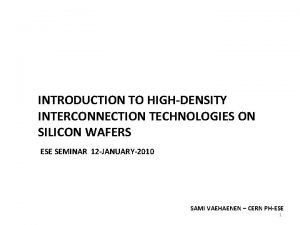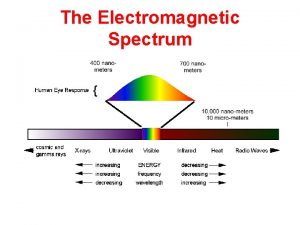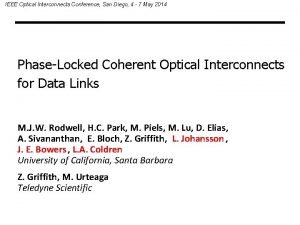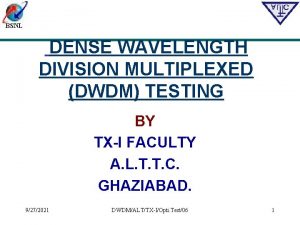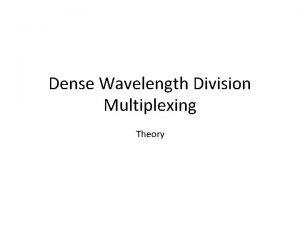Dense Wavelength Division Multiplexed Interconnects for High Performance






- Slides: 6

Dense Wavelength Division Multiplexed Interconnects for High Performance Embedded Computing Architectures Aaron M. Cordes & Rick C. Stevens Lockheed Martin Mission Systems and Sensors (MS 2)

Dense Wavelength Division Multiplexing (DWDM) · DWDM fiber optic interconnects form the infrastructure for telco industry’s high-bandwidth backbones · Numerous advantages over electrical interconnects - Extremely high data capacity (100’s of Gbps to 10’s of Tbps per fiber). - Improved signal integrity leading to increased link distances. - EMI immunity. - The ability to increase data rates and add communications channels without changing the cabling infrastructure. - Lower-weight cabling. · To date, environmental and packaging concerns have limited the applicability in HPEC systems 2

Passive DWDM Networks · Wavelengths are centered around C-Band (1550 nm) or L-Band (1595 nm) - Spaced at 50, 100, or 200 GHz increments - Conforms to ITU grid · Passive combiners and splitters permit full connectivity between endpoints - Active components isolated to Tx/Rx endpoints · Creates a passive, optical broadcast interconnect that is protocol and data-rate agnostic 3

Application of Passive DWDM Interconnects to HPEC Systems · Additional endpoints can be added to system with no impact on previously installed hardware - Enables low-cost technology insertions · Can carry multiple protocols on a single fiber at multiple signaling rates - 10 G Ethernet, 1 G Ethernet, SRIO, Fibre Channel, Infiniband, custom, etc. - Allows I/O-challenged systems to push beyond their current limitations · Eliminates contention and blocking in the network - All endpoints are assigned a unique wavelength for transmission · Allows new levels of sensor data sharing - Data is inherently broadcast to all endpoints with no additional overhead · Eliminates the need for switching hardware, reduces SWa. P 4

Challenges of Passive DWDM Interconnects in HPEC Systems · Reduction of the SWa. P envelope of the DWDM transmit and receive endpoints so that they can be designed into standard HPEC form factors such as PMC, XMC, and VPX. · Hardening the active components against the temperature, shock, vibration, and other environmental requirements encountered in HPEC systems. · Addressing Information Assurance (IA) and Multi-Level Security (MLS) requirements by developing a secure passive infrastructure for systems where data separation must be provided. · Developing endpoint firmware that leverages standard highspeed point-to-point protocols, such as Serial Rapid. IO or 10 Gigabit Ethernet, while updating them to support the DWDM broadcast interconnect. Lockheed Martin MS 2 is actively addressing each of these challenges 5

6

